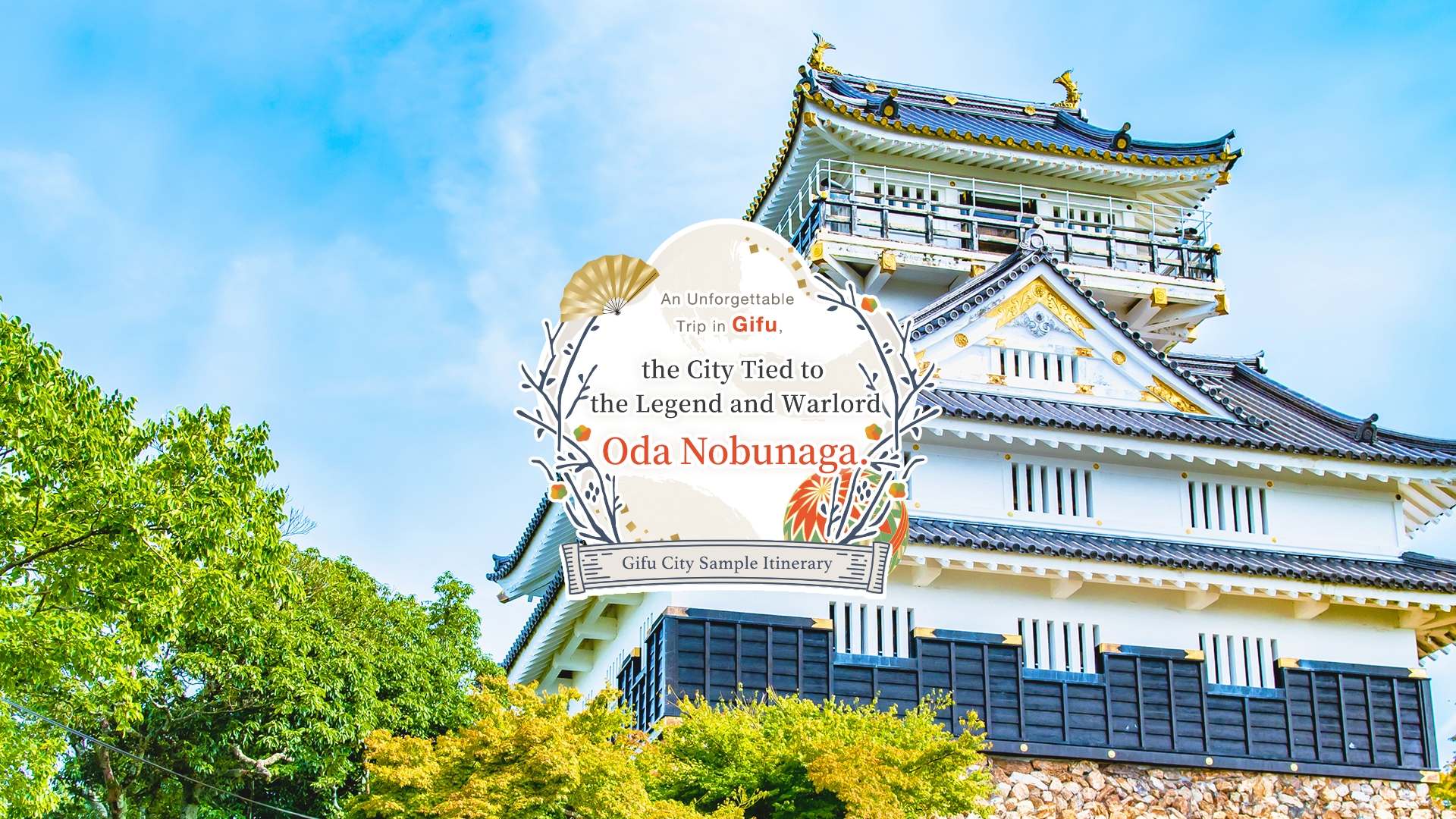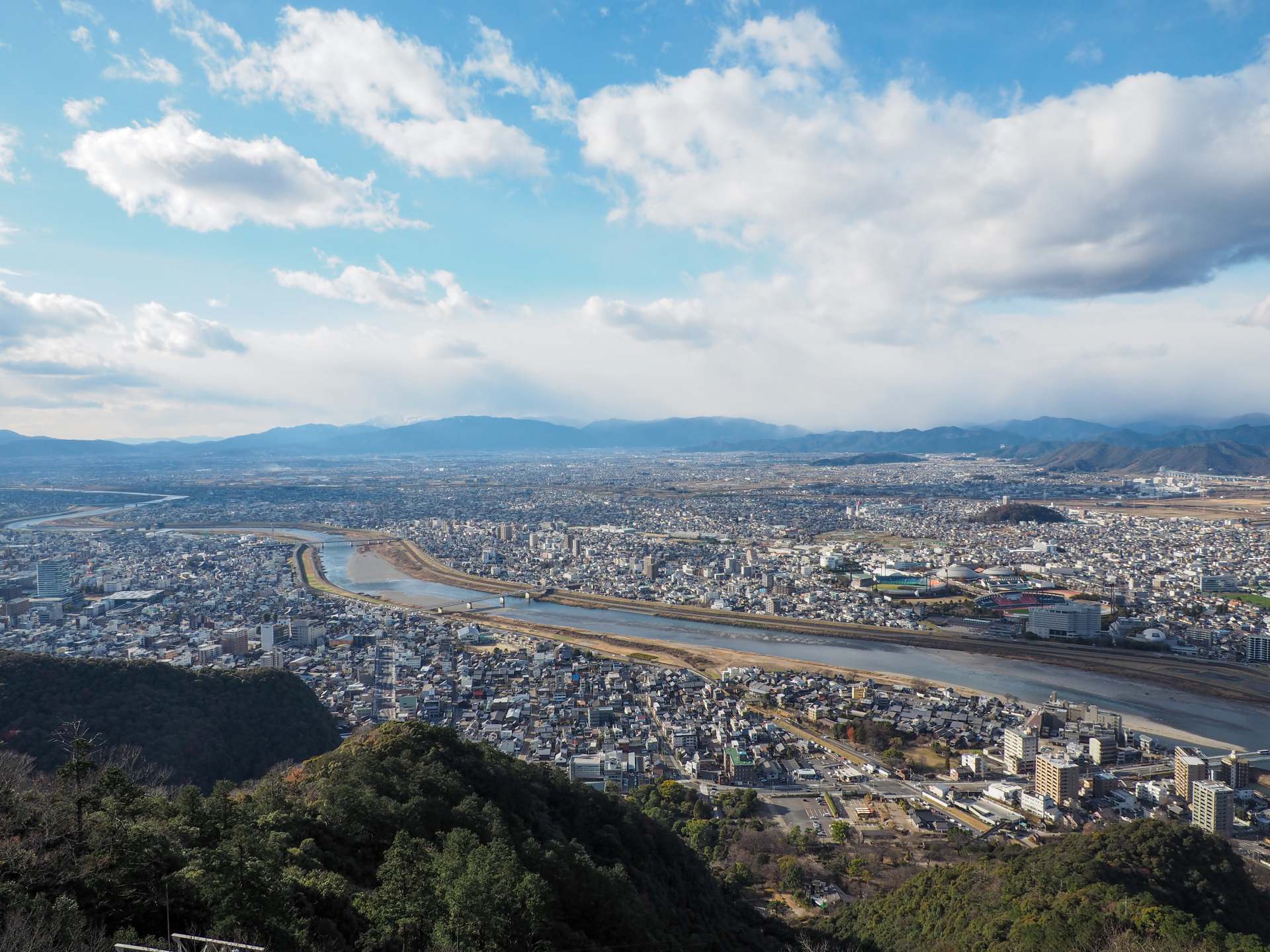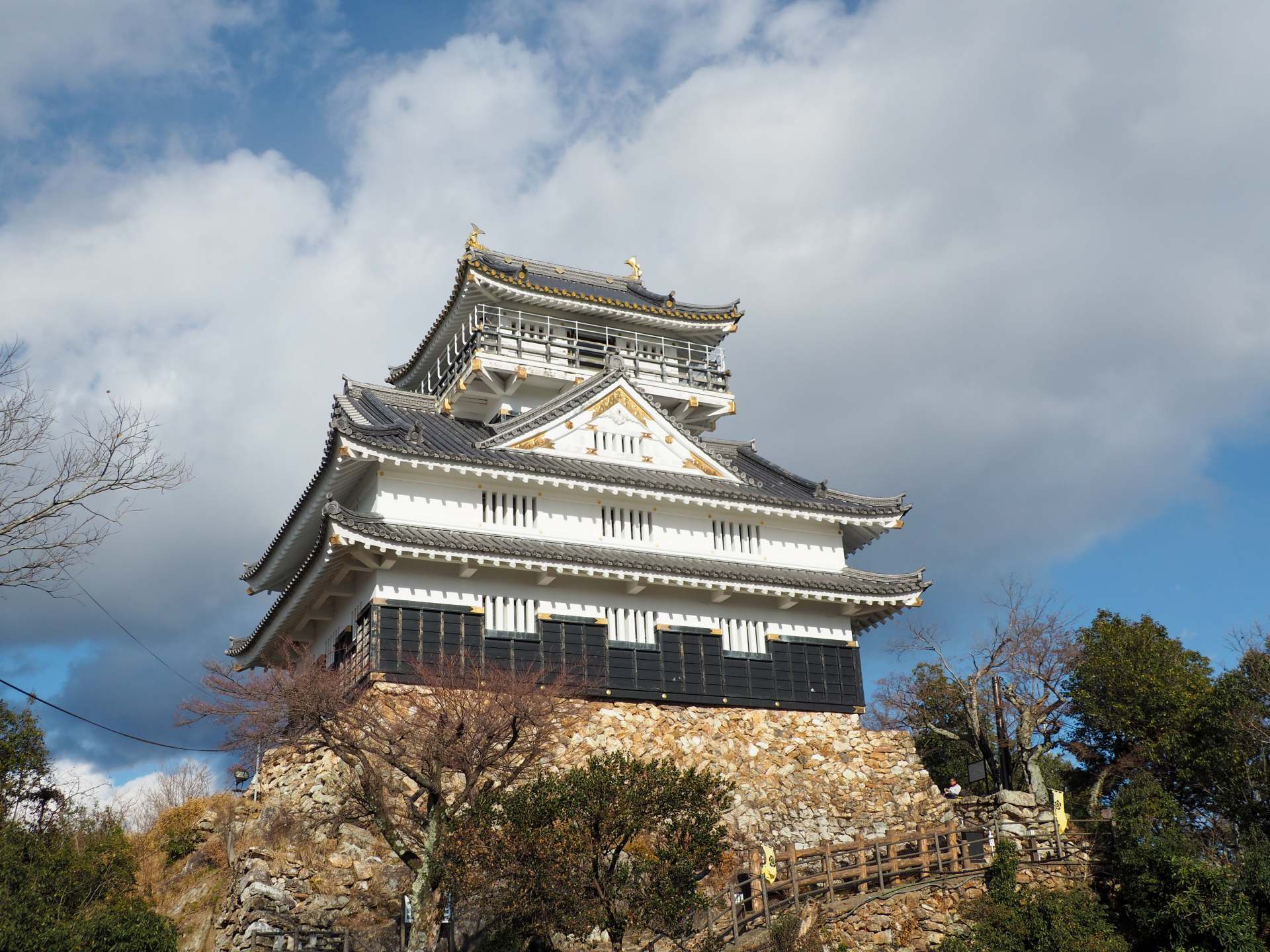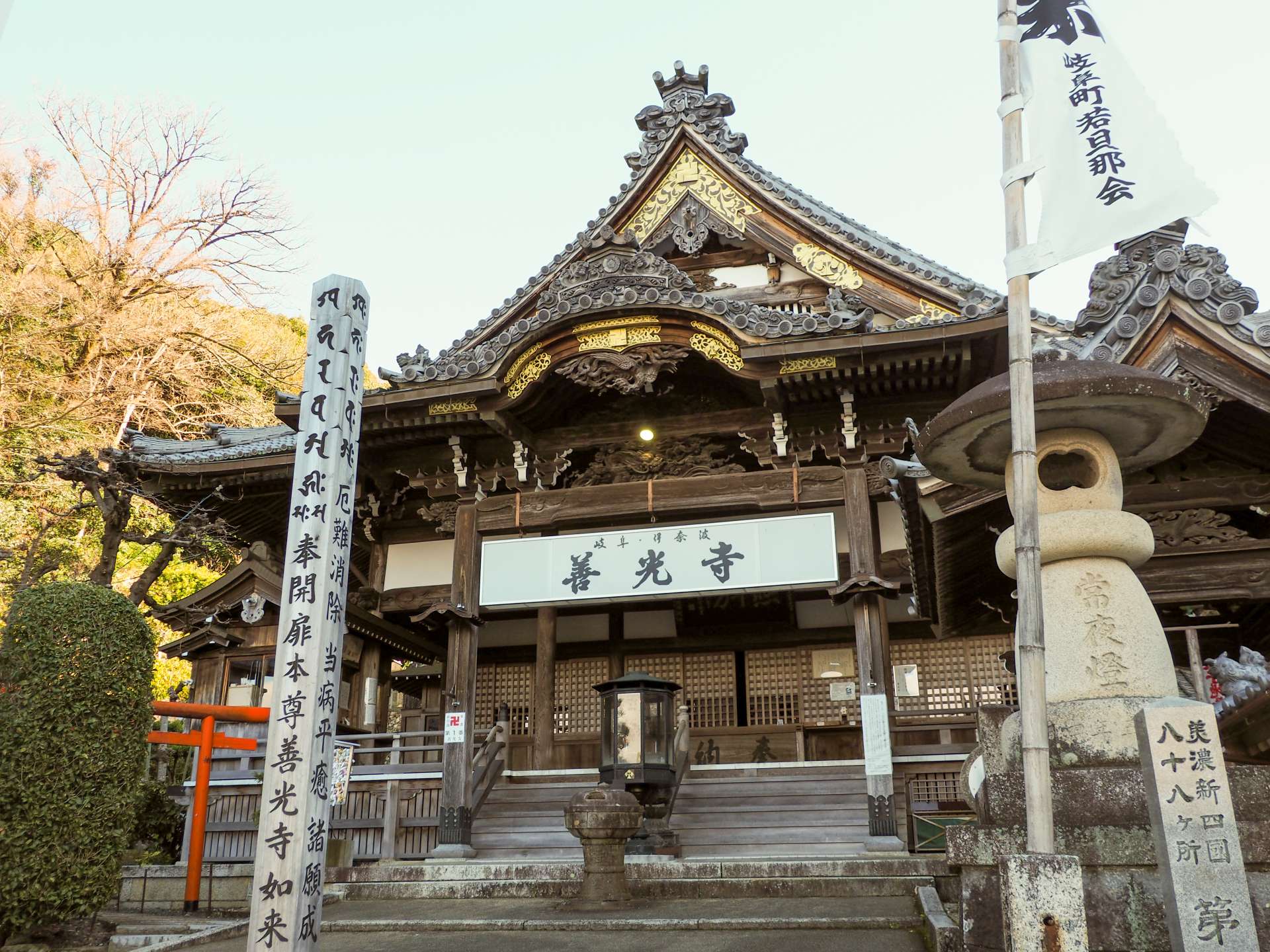
[Gifu City Sample Itinerary] An Unforgettable Trip in Gifu, the City Tied to the Legend and Warlord Oda Nobunaga.
Oda Nobunaga (1534-1582), a charismatic legend from the Sengoku period (circa 1467-1615), is known for toppling countless rival warlords and nearly unifying Japan. History tells that he kept Gifu as a strategic base during his long campaign, playing a crucial roll as he pursued national unification. Step inside today to see the city of Gifu dotted with landmarks linked to Nobunaga like Gifu Castle and other acclaimed sites that carry all the pomp and circumsstance of a real Nobunaga welcome. Here’s a roundup below.
Table of Contents
How to Get to Gifu City
Gifu Prefecture is located in the central inland region of Japan. Gifu City, the prefectural capital, is situated in the southern part of the prefecture and is geographically close to Nagoya, the largest city in the Chubu region.
The most common way to reach Gifu City is by changing from the Shinkansen "Nozomi" at Nagoya Station to a JR conventional line. Nagoya is a city between Tokyo and Osaka; by Shinkansen, it takes about 1 hour and 30 minutes from Tokyo, about 1 hour from Osaka, and about 40 minutes from Kyoto. From Nagoya Station to Gifu Station, it's approximately a 20-minute journey on a JR rapid train.
If heading in from Chubu Centrair International Airport (Centrair), Nagoya Railroad (Meitetsu) is a convenient route. There are direct limited express trains from Centrair Airport Station to Meitetsu Gifu Station, allowing for a transfer-free journey of about 1 hour.
From Takayama, a major city in the northern part of Gifu Prefecture, it takes about 2 hours by the JR conventional line limited express "Hida." Takayama and Shirakawa-go, popular with foreign tourists, are perfect add-on destinations to visit before or after exploring Gifu City, which retains a globally coveted, rich Japanese cultural heritage.
Transportation within Gifu City
Many of the spots below are found around Gifu Park, making for an easy, compact trip.
In the city, buses are the primary mode of transportation. There are frequent buses heading towards "Nagara Bridge," the main route to Gifu Park, so you can get around with minimal waiting. Buses to this area board both at JR Gifu Station and Meitetsu Gifu Station.
As an alternative, the park area is just a 15-minute drive from JR/Meitetsu Gifu Station, making taxis a convenient option.
Another fun option for getting around this compact city is the bike-share service, “Gifu-ride". There are 24 cycle ports set up around the city (as of January 2024), where you can borrow and return bikes freely, except at a few locations. This service is available 24 hours and there’s even a wallet-friendly "1-Day Flat Rate Plan" (from 600 JPY) for tourists. App download is required to ride.
Best things to do on a trip in Gifu, the city linked to legendary warlord Oda Nobunaga!
10:00am Meet the Golden Statue of Nobunaga at JR Gifu Station!
Arrive at JR Gifu Station, the main gateway to Gifu City, and look up see the grand welcome from the looming, golden statue of Oda Nobunaga. The entire statue measures at 8 meters tall from base to top, while the 3-meter high likelness of Nobunaga glimmers in three resplendent layers of gold leaf. This particular version of Nobunaga with a cape and gun in his right hand that hails from Tanegashima (an island now part of Kagoshima Prefecture) with a Western helmet in his left. Just as Nobunaga, this imagery shows off his early flair for adoping Western culture. With this grand welcome its time to kick off your journey across Gifu City, a place deeply connected to Nobunaga's history and legacy.

10:30am Stroll through Gifu Park, Where Nobunaga's Residence Once Stood
Gifu Park, located at the base of Mount Kinka and crowned by Gifu Castle, serves as a central spot for tourism. It's a beloved place of relaxation for both locals and visitors.
This place was once home to the expansive residences of Saito Dosan, a Sengoku period warlord and lord of Gifu Castle who was also Oda Nobunaga's father-in-law, as well as Nobunaga's own residence. Archaeological excavations are still ongoing here to uncover more of its history.
* The park is currently under renovation. It is scheduled to reopen by the end of March 2025.


11:00 Learn about the Sengoku Period and Nobunaga's Era at the Gifu City Museum of History
Swing by the Gifu City Museum of History for a deep dive into Oda Nobunaga and his days during the Sengoku Period before heading up to Gifu Castle at the top of Mount Kinka.

Step inside to see especially detailed exhibits surrounding the Sengoku period, the main theme of this trip. Be sure to stop by the recreation of the castle town in Gifu, which thrived in its heyday under the Nobunaga “Rakuichi Rakuza” policy. In addition to liberalizing commerce, this police is said to have bolstered the underlying economy of the castle town. Like this and other exhibits, your stop here will shine a spotlight not only on Nobunaga’s military prowess, but also his long-tolled charisma, and penchant for innovative styles of governance.

See into the Sengoku period with your eyes, using armor, helmets and picture scrolls to better visualize the day and age. The Tenka Chobo Emaki (Bird's-eye View of the Country) exhibit is especially worthwhile, using videos and dioramas to create an immersive experience.

12:00pm Head to the Summit of Mount Kinka on the Mt. Kinka Ropeway!
Take to the skies on this ropeway connecting Gifu Park where Nobunaga once resided to Gifu Castle on the summit of Mount Kinka. The military stronghold of Oda Nobunaga at your footsteps in just about 4 minutes.

From the gondola, you can take in panoramic views of Mount Kinka, covered in natural forests, the Nagara River, and the cityscape of Gifu. At the summit, not only is there Gifu Castle, but also plenty of perks to explore like a restaurant and the "Gifu Kinkazan Squirrel Village" where you can interact with squirrels for extra thrills and fun.


12:15pm Lunch at a Scenic Restaurant Overlooking Gifu City!
Before visiting Gifu Castle you’ll pop in for lunch at Le Pont de Ciel near the mountain's summit station. Enjoy your meal served with a side of full panoramic views out over Gifu City.
The restaurant features dishes made with local ingredients, including the world-renowned Hida beef and branded pork from Gifu Prefecture. Almost dishes are prepared by hand. Not only the main ingredients but also the miso, soy sauce, and other seasonings are predominantly locally sourced, allowing you to truly experience the richness of Gifu's cuisine.

On the menu you’ll find an eclectic listing of dishes named for Sengoku period warlords, a delightful touch for history buffs. Particularly noteworthy is the Nobunaga Dote-don, a specialty dish of carefully stewed beef tendons and pork offal in miso. The miso used is a bean miso from "Imo Yoshii”, a long-established brewery in Gifu City. Packed with plenty of sweet and spicy flavor, this must-try dish pairs especially well with rice at hand.

Be sure to try this rare delight, Nobunaga Banana Ice Cream, made with pesticide-free bananas grown in Gifu Prefecture. It’s prepared simply with just a hint of milk so you can enjoy the rich, natural taste of honest-to-goodness banana. Trivia lovers will love knowing the fun fact that Portuguese missionary Luis Frois is recorded historically having presented bananas to Nobunaga in 1569. Some say that Nobunaga might have been the first Japanese person to eat a banana.

1:30pm Visit the Grand Mountain Fortress Gifu Castle atop Mount Kinka
Just about a 10-minute walk from the summit station of the Mt. Kinka Ropeway and the restaurant stands Gifu Castle, perched on the peak of Mount Kinka.
Originally known as Inabayama Castle, this site once served as the residence of Saito Dosan. In 1567, Nobunaga captured this castle and subdued the surrounding area. He renamed the area from "Inokuchi" to "Gifu”, giving the region a new name still used today.


Nobunaga named the area Gifu, and set the city as the base while pursuing the unification of Japan. From the top floor of the castle you can enjoy a clear westward view towards the former capital, almost like Nobunaga himself wile taking in the panoramic view.

2:30pm Visit Gifu Daibutsu, One of Japan's Three Great Buddhas
Head back to the foot of the mountain via ropeway to visit Shoboji Temple where sits Gifu Daibutsu, Japan's largest dry lacquer Buddha which is counted among the three great Buddhas of Japan.
Completed in 1832, this significant, historic structure was built 250 years after Nobunaga's death over a period of 38 years. By this time, Nobunaga's residence and the Gifu Castle tower had been lost. The Daibutsu-den (Great Buddha Hall) built subsequently was considered a considerably tall structure for its time.


3:15pm On to Gifu Zenkoji, the Once Home to the Zenkoji Daibutsu
Next, take the Gifu Bus from "Gifu Park History Museum-mae" to "Inaba Dori”, about a 3-minute ride, followed by a 5-minute walk to "Gifu Zenkoji”.
Gifu Zenkoji was established when Nobunaga, after becoming the lord of Gifu Castle, moved the "Zenkoji Daibutsu" (Buddha statue) from Zenkoji Temple in Shinshu (now Nagano Prefecture) to Gifu. This statue had previously been moved from Zenkoji to Kofu in Yamanashi Prefecture by Takeda Shingen, a warlord from Kai (now Yamanashi Prefecture). The history of the Zenkoji Daibutsu, constantly relocated yet carefully preserved by the power holders of the time, is particularly fascinating.


4:00pm A Quick Prayer at Sofukuji Temple, Protected by the Oda Family as a Family Temple
Sofukuji Temple is an absolute must-visit that was once kept by Nogunaga as a protected family temple when he moved to Gifu in 1567. To get here, take the Gifu Bus City Loop Line (left loop) from "Ina Dori" bus stop for about 10 minutes, get off at "Nagaragawa International Conference Hall North Entrance," and walk for about 3 minutes to arrive.
After Nobunaga and his son Nobutada were slain by Akechi Mitsuhide during the Honno-ji Incident, their relics were sent to this temple. Here at the temple garden you can view the Oda Nobunaga and Son Mausoleum where their memorial tablets are enshrined. This tranquil escape offers a chance to pay respects in quiet while reflecting on the great significance of the Oda family.


4:30pm A Heritage of Gifu Traditional Culture at the Nagara River Ukai Museum
An indispensable element of Gifu City's heritage is “ukai”, a tradition of cormorant fishing on the Nagara River that’s kept it’s iconic Japanese roots for over 1,300 years.
Cormorant fishing, or “ukai" in Japanese, is a traditional fishing method where skilled fishermen use trained cormorants to catch fish. Visitors can observe this unique fishing technique on the waterfront by riding on Ukai viewing boats. It's said that Nobunaga also entertained envoys from Takeda Shingen, the warlord who ruled Kai (now Yamanashi Prefecture), with cormorant fishing displays.

The "Gifu Cormorant fishing on the Nagara River" is a seasonal event, typically held from May 11th to October 15th each year. However, even during the off-season, you can still experience its mystical charm at the Nagara River Ukai Museum. Step inside to find the acclaimed Guidance Theater where life-size Ukai boats and realistic sound and lighting effects offer the thrilling look and feel of cormorant fishing.

If you plan to visit Gifu City during the season of ukai along the Nagara River, be sure to catch the fishermen live after swinging by the museum.

【Staying Overnight?】 Enjoy Gifu City at Night!
A visit to Gifu City during ukai season (usually from May 11th to October 15th) promises a vibrant night scape as cormorant fishing happens at Nagara River each evening. Book an inn with hot springs from Nagaragawa Onsen to truly treat yourself this trip.
Experience 1300 Years of Tradition and Artistry! Enjoy a Gifu Evening with a View of Nagaragawa Cormorant Fishing
Ukai fishing on the Nagara River is a heritage passed down for over 1300 years, where skilled fishermen known as "Usho” work hand-in-hand with the flock to catch the river fish below. Stand amazed as the fishermen expertly handle up to twelve ropes simultaneously to direct the cormorants. It's said that Nobunaga was the first to introduce cormorant fishing as a form of entertainment and hospitality, turning it into a captivating display.

Check Out These Events Too! Diverse Ways to Enjoy Gifu City at Night
Gifu Light Story
A light-up event that features traditional crafts designated by the nation, such as Gifu umbrellas and Gifu lanterns. This event is typically held in late January each year.

Gifu Castle Panoramic Night View
For a limited period, Gifu Castle offers extended evening hours and a 360-degree panoramic view of Gifu city's nightscape.

Snag some Special Tickets for a Pub Crawl in the Tamamiya Drinking District by the Station!
Tamamiya is the bustling district located in the northern area of JR Gifu Station. Here you’ll find some 400 different eateries, including a cohort of many serving local Gifu cuisine. Be sure to grab a Tamamiya Sightseeing Ticket issued by the Gifu Hotel Association Office to make the most of a wallet-friendly, safe and thrilling night trying different izakaya (Japanese pubs).

Recommended Stays in Gifu City!
Gifu City boasts a variety of different stays to try including city hotels and hot spring ryokans where you can enjoy the waters of Nagaragawa Onsen.
Juhachiro
Juhachiro is a historic ryokan established in 1860 along the banks of the Nagara River. It features two large communal baths that open alternatively by gender with the uniquely tea-brown waters of Nagaragawa Onsen, rich in iron and radon.

Comfort Hotel Gifu
Just about a 2-minute walk from JR Gifu Station and close to the bustling Tamamiya district sits Comfort Hotel Gifu, home to easy access and wallet-friendly rates. The complimentary breakfast is a delightful bonus, featuring a buffet-style spread with a focus on Western dishes and local ingredients.

【Enjoy an Extra Day】 Strolling through Kawaramachi Streetscape, a Japanese Heritage Site Left by Nobunaga
If your plans include an overnight stay in Gifu City this is the perfect chance to take up a stroll through Kawaramachi Streetscape on day two to see all the flair or charming Japanese houses.
The area's development began with Nobunaga designing the entire castle town as a space to entertain those visiting Gifu. It is now recognized as a Japanese Heritage site, celebrated as "The Sengoku Period Castle Town of Gifu, Alive with Nobunaga’s Hospitality." Recently, the area has seen an increase in eateries and shops utilizing old folk houses, making for an enjoyable stroll.

Kick off this adventure by renting an antique kimono from ORGAN Kimono inside the Nagaragawa Department Store. With kimono and classic old-world streets to walk, here’s a chance to take plenty of unforgettable photos.
Inside the Nagaragawa Department Store you’ll even find local boutiques selling Gifu's traditional crafts like Mino washi paper, lanterns, fans, and umbrellas. Participate in popular experiences like painting your own designs on plain Gifu lanterns, meticulously crafted by local artisans.


A must-visit for souvenir shopping is the Japanese confectionery shop Ryokusuian, located near the ukai boarding docks. The specialty here is Tobiayu, a famous Gifu confection made with premium dried persimmons called "Dojo Hachiya Persimmon," which were even presented to Nobunaga himself. Bite into a Tobiayu to taste moist spongecake wrapped around a paste of dried persimmons. The shop even has an eat-in space, ideal for a break during your stroll.

Four Recommended Gourmet Picks in Gifu City
Regional foods are one of the undoubtable perks of traveling. Below is a smorgasbord of Gifu's culinary delights, from the world-famous "Hida beef" to unique local specialties known mostly to Gifu's residents.
Hida Beef at Hidagyuittoya Bakuroichidai GifuKanda
Saitobi beef is a selection of Hida beef that surpasses even the A5 grade classification, essentially the highest quality beyond standard rankings. Enjoy a bite that tastes like excellence, either as yakiniku (grilled meat) or shabu-shabu.

Ayuryori (Sweetfish Cuisine) at Kawaramachi Izumiya
A specialty restaurant where you can enjoy natural sweetfish to your heart's content. In addition to course meals, you can also order bento boxes to enjoy on a cormorant fishing viewing boat (advance reservation required).

Hiyashi Tanuki at Sarashina
Hiyashi Tanuki is one dish that’s remained true since it first hit the menu. "Tanuki soba" typically refers to soba topped with tempura bits, but in Sarashina's version you’ll find a unique spin using deep fried tofu as well.

Koutou Rice at Ajiro-tei
The almost puzzling Koutou Rice awaits for you to taste at one of Gifu City's oldest Western-style restaurants. It resembles a curry rice topped with a fried egg, but it's not as spicy as traditional curry and is known for its smooth texture.

Wrap-Up
With this handy guide there’s no doubt why so many come to Gifu, the city with a true Nobunaga fashioned welcome. Make sure to earmark this sample itinerary as a reference before planning your next trip into all the deep culture, history, hot springs and delicious eats that await in Gifu! To top it all off, the same stunning landscapes and natural beauty that Nobunaga cherished are still here just waiting for you to explore.

Step up and see "ukai sakura”, flanked along the Nagara River embankment on the Gokoku Shrine grounds where over 150-year-old Higan cherry trees (Edo Higan) await. The best time to view these cherry blossoms is typically from mid to late March. In autumn, the maple leaves at Dairyoji Temple simply can’t be missed, found at this site that’s also loved for its some 1,200 Thunberg's meadowsweets (Doudan Tsutsuji) plants, thriving in the temple garden and the hill behind.
If you visit Gifu City in spring or autumn, be sure to add in these natural highlights along the way for a picture-perfect look at the city.
